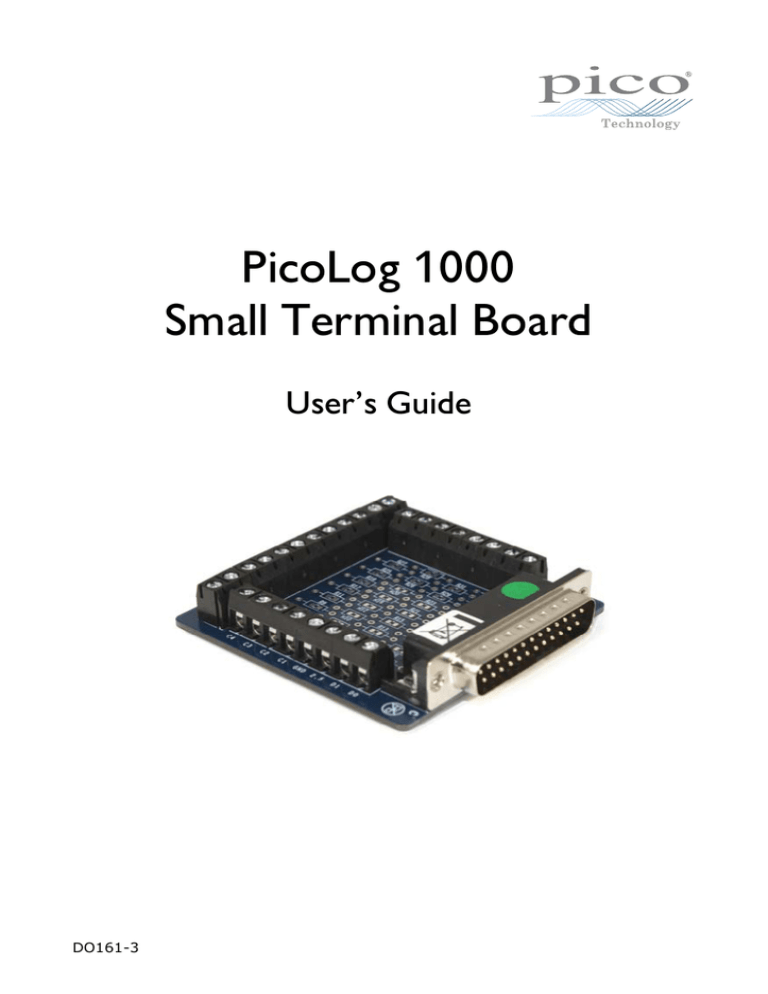
PicoLog 1000
Small Terminal Board
User’s Guide
DO161-3
Pico Technology
Small Terminal Board User Guide
CONTENTS
1 Overview
1.1 Introduction
1.2 Specifications
1.3 Connecting the Terminal Board to the Data Logger
1.4 Terminals and solder pads
2 Making measurements
2.1 Measuring voltages up to +2.5 V
2.2 Measuring voltages above +2.5 V
2.3 Offsetting and scaling the sensor signal
2.4 Resistor Connections
2.5 Measuring current
DO161-3
1 1 1 1 2 2 2 3 4 5 7 i
Small Terminal Board User Guide
ii
Pico Technology
DO161-3
Pico Technology
1
Overview
1.1
Introduction
Small Terminal Board User Guide
The Small Terminal Board (PP545) is an accessory for the PicoLog 1012 and 1216
Data Loggers. The screw terminals allow sensor wires to be attached to the data
logger without soldering. The terminal board also has locations where you can fit
resistors to extend the input ranges of the logger.
Figure 1 - Small Terminal Board
1.2
1.3
Specifications
Dimensions
66 x 72 x 17 mm (approx. 2.6 x 2.83 x 0.67 in.)
Weight
50 g nominal (approx. 1.76 oz)
Terminal wire size
0.6-1.6 mm (14-22 AWG)
Connecting the Terminal Board to the Data Logger
You can plug the Terminal Board directly into the analog connector on the PicoLog
Data Logger, or you can use a standard 25-way male-D to female-D parallel cable
to connect the two units.
Using a cable will increase the noise and crosstalk between channels. If you make
your own cable, you can minimise this problem by using a signal/ground twisted
pair for each channel.
DO161-3
1
Small Terminal Board User Guide
1.4
Pico Technology
Terminals and solder pads
The table below shows the purpose of each of the screw terminals and resistor
locations on the Terminal Board. For details of the inputs and outputs of the data
logger, see the PicoLog 1012 and 1216 User’s Guide.
Marking on
Terminal
Board
Description
C1…C16 *
Analog input channels 1 to 16 *
D0…D3
Digital outputs
GND
Circuit ground
2.5
2.5 volt power output for sensors
PWM
Pulse-width modulated output
R1, R3, R5 etc.
Locations for 0805 or leaded series resistors in analog inputs (see
Figure 5). Before you fit a resistor in one of these sites, you must
cut the track under the component (see Figure 6).
R2, R4, R6 etc.
*
Solder pads for 0805 or leaded shunt resistors between each
analog input and GND (see Figure 5).
The PicoLog 1216 has channels 1 to 16.
The PicoLog 1012 has channels 1 to 12.
Table 1 - Terminals and resistor sites
2
Making measurements
2.1
Measuring voltages up to +2.5 V
For voltage sources from 0 V to +2.5 V, you can connect directly to any analog
input channel. With this method, there is no need to fit any additional components
to the Terminal Board.
Figure 2 shows analog channel 1, but the connections are similar for the other
channels.
Small Terminal Board
PicoLog Data Logger
C1
VIN
(0 V to
+2.5 V)
Channel 1
RADC
1 MΩ
VADC
GND
GND
Figure 2 - Direct input to channel
2
DO161-3
Pico Technology
2.2
Small Terminal Board User Guide
Measuring voltages above +2.5 V
For voltages above +2.5 V, use a voltage divider connection. You must cut one
track on the Terminal Board and fit two 0805 surface-mount, or axial leaded,
resistors for each channel that you wish to use in this way.
Figure 3 shows the voltage divider circuit for analog channel 1, but the connections
are similar for the other channels.
PicoLog Data Logger
Small Terminal Board
R1
Channel 1
C1
VIN
Channel 1
R2
RADC
1 MΩ
VADC
GND
GND
Figure 3 - Voltage divider
The voltage that the ADC sees, VADC, depends on VIN and the values of R1 and R2,
and is given by the following equation:
VADC
VIN R2
R1 R2
Choose values of R1 and R2 so that VADC is approximately +2.5 V when VIN is at its
highest.
To minimise errors in the measured voltage, VADC, caused by loading of the source
voltage VIN, ensure that the combined resistance of R1 + R2 is much greater than
the resistance of the voltage source. If you are unsure of the resistance of the
voltage source, use large values for R1 and R2 such that R1 + R2 is about 10 kΩ.
If you have chosen a value for R2 that is greater than 10 kΩ and you need high
accuracy, then you will need to take into account the ADC’s input resistance RADC,
which is in parallel with R2. Use the following formula to obtain a value for the
parallel equivalent resistance of R2 and RADC, RP:
RP
R2 R ADC
R2 R ADC
where RADC = 1 MΩ, and then use RP instead of R2 in the previous formula.
DO161-3
3
Small Terminal Board User Guide
2.3
Pico Technology
Offsetting and scaling the sensor signal
Example using a 2.5 V input
It is possible to offset and scale the ±5.0 V signal from your sensor. There is a
+2.5 V, 10 mA source available on the PicoLog Data Logger.
Assuming you are using channel 1, add a 20 kΩ surface mount or leaded resistor in
position R1 (cutting the link as in Figure 6). Add a second 20 kΩ surface mount or
leaded resistor in position R2. Finally, to give the correct offset and final scaling you
must add a 10 kΩ leaded resistor in position R33. These three resistors will scale
the ±5 V output of your sensor to a signal at the logger varying from 0 V to +2.5 V.
The scaling function of PicoLog can convert this reduced and offset range back to
the original voltage reading by mathematically subtracting 1.25 V and multiplying
the remainder by 4. To compensate for any residual errors, the actual scaling offset
and multiplier can be slightly varied to give exact readings by doing a simple
calibration, if required.
If required, all 16 channels can be offset in this way. The above values allow use up
to the full analogue bandwidth of the PicoLog of 70 kHz but the input impedance is
reduced from 1 MΩ to about 27 kΩ.
If a higher input impedance is required, replace R1 with 1 MΩ, do not fit R2 at all
and for the R33 use 500 kΩ (two 1 MΩ in parallel). This will give an input
impedance of over 1 MΩ but the frequency response will fall to about 1 kHz.
In both cases, when no input is connected, the DC voltage will float up to 1.66 V.
As long as the output impedance of the sensor you are feeding to the input of the
PicoLog is much lower than input impedance of the circuit above, the DC level is
pulled to the correct value upon connection.
Small Terminal Board
PicoLog Data Logger
R33
(10 k)
R1
(20 k)
+2.5 V
Channel 1
C1
VIN
(±5.0 V)
GND
R2
(20 k)
RADC
1 MΩ
VADC
0 to 2.5 V
GND
Figure 4 – Offsetting and scaling the signal
4
DO161-3
R11
R43
R7
R39
IN_CH4
IN_CH6
R5
R37
IN_CH3
R9
R41
R3
R67
IN_CH2
IN_CH5
R1
R65
R66
R2
R68
R4
R38
R6
R40
R8
R42
R10
IN_CH1
R44
R12
OUT_CH4
OUT_CH3
OUT_CH2
OUT_CH1
OUT_CH6
OUT_CH5
R36
R35
R34
R33
IN_CH12
IN_CH11
2.5V
R23
R55
R21
R53
IN_CH10
IN_CH9
IN_CH8
IN_CH7
R54
R22
OUT_CH12
OUT_CH11
R19
R51
R17
R49
R15
R47
R13
R45
R46
R14
R48
R16
R50
R18
R52
R20
IN_CH15
IN_CH16
OUT_CH10
IN_CH14
IN_CH13
OUT_CH9
OUT_CH8
OUT_CH7
R31
R63
R29
R61
R27
R59
R25
R57
R58
R26
R60
R28
R62
R30
DO161-3
R64
R32
OUT_CH16
OUT_CH15
OUT_CH14
OUT_CH13
2.4
R56
R24
Pico Technology
Small Terminal Board User Guide
The resistors on the Small Terminal Board are connected as shown in Figure 5.
Resistor connections
Figure 5 - Voltage divider resistor sites
5
Small Terminal Board User Guide
Pico Technology
The location for each series resistor (R1 and so on) is bypassed by a copper link.
You must cut this link (see Figure 6) before fitting the resistor.
Cut this link
before fitting
R1
Figure 6 - Location of copper link under R1
The following noise problems are often associated with potential divider circuits:
1. Noise from source voltage
2. RF interference picked up at
high-impedance points
3. Noise on the earth connections
Try fitting a capacitor as described
below.
Smaller values for R1 and R2 may help
The signal 0 V line is connected to
mains earth. Try to avoid this
situation.
Should either 1 or 2 above occur and you want to try a capacitor, ensure that you
have fitted resistor R1 and cut the corresponding track beneath the resistor. Fit the
capacitor in place of or in parallel with R2, as necessary. Use the following formula
for C, the value of the capacitor:
C
1
2πf R
where R is R1 or the smaller of R1 and R2, and f is the highest signal frequency in
hertz.
6
DO161-3
Pico Technology
2.5
Small Terminal Board User Guide
Measuring current
You can use measure current towards ground by using a simple shunt resistor to
convert the current into a voltage before measuring with the ADC.
Figure 7 shows the circuit for analog channel 1, with shunt resistor R2. A similar
circuit can be used for the other channels.
Small Terminal Board
PicoLog Data Logger
IIN
Channel 1
C1
VIN
R2
RADC
1 MΩ
GND
VADC
GND
Figure 7 - Shunt resistor circuit
You will need to calculate the resistor value R2 from the following equation:
R2
2.5 V
I MAX
where IMAX is the highest current you want to measure.
Warning!
Under no circumstances use this method for measuring mains (house)
currents. The Small Terminal Board is not designed to be connected to the
mains. Attempting to do so could result in serious property damage and
personal injury.
DO161-3
7
Small Terminal Board User Guide
Pico Technology
Issues:
1)
2)
3)
14.5.09. New for PicoLog 1012 & 1216.
11.2.11. New SMT design.
04.1.13. Title changed
Pico Technology
James House
Colmworth Business Park
St. Neots
PE19 8YP
United Kingdom
www.picotech.com
Pico Technology is a registered trademark of Pico Technology Ltd.
Copyright © Pico Technology Ltd. 2009-2013
All rights reserved
8
DO161-3



